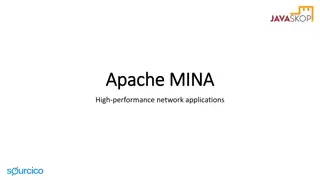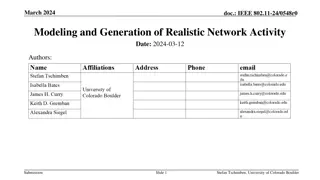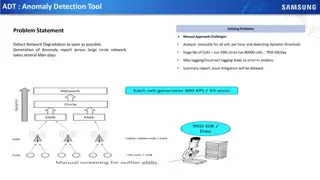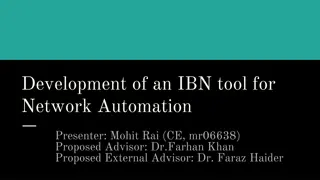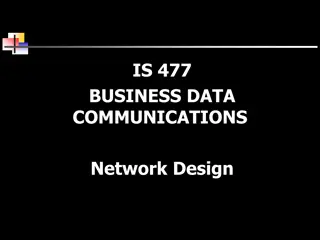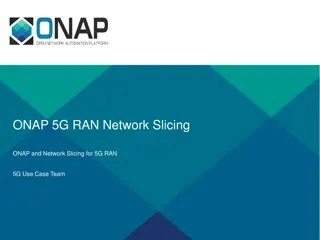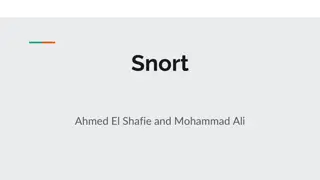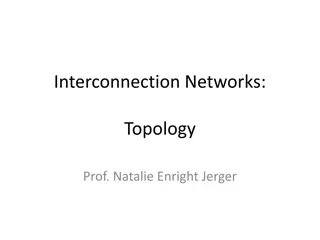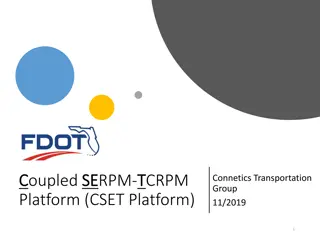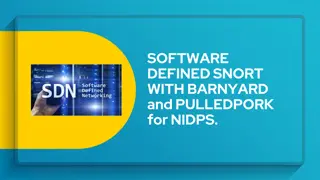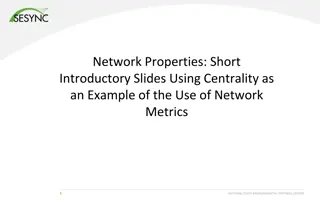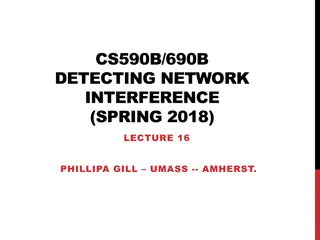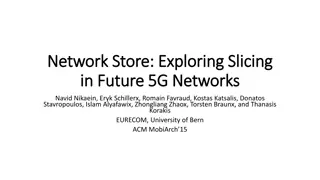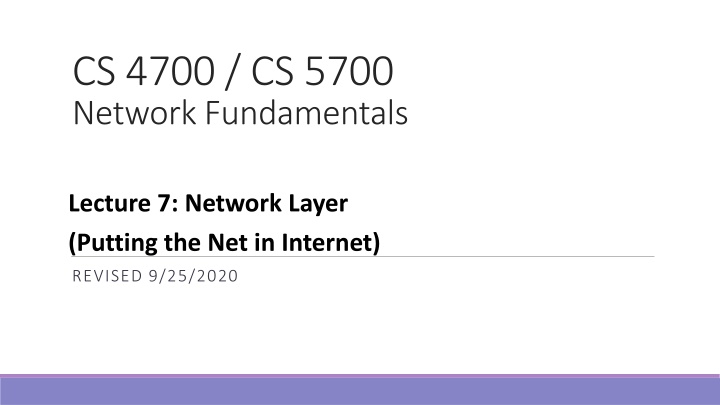
Network Layer Fundamentals - Routing and Internetworking
Explore the essentials of the network layer, focusing on routing packets through networks, the role of routers in connecting LANs, the structure of the internet, internetworking challenges such as addressing and naming, and different addressing schemes. Delve into topics like IP protocols, network hierarchy, and scalability in network design.
Uploaded on | 1 Views
Download Presentation

Please find below an Image/Link to download the presentation.
The content on the website is provided AS IS for your information and personal use only. It may not be sold, licensed, or shared on other websites without obtaining consent from the author. If you encounter any issues during the download, it is possible that the publisher has removed the file from their server.
You are allowed to download the files provided on this website for personal or commercial use, subject to the condition that they are used lawfully. All files are the property of their respective owners.
The content on the website is provided AS IS for your information and personal use only. It may not be sold, licensed, or shared on other websites without obtaining consent from the author.
E N D
Presentation Transcript
CS 4700 / CS 5700 Network Fundamentals Lecture 7: Network Layer (Putting the Net in Internet) REVISED 9/25/2020
Network Layer Function: Route packets end-to-end on a network, through multiple hops Application Key challenge: How to represent addresses How to route packets Scalability Convergence Presentation Session Transport Network Data Link Physical 2
Routers, Revisited How to connect multiple LANs? LANs may be incompatible Ethernet, Wifi, etc Routers Connected networks form an internetwork The Internet is the best known example 3
Structure of the Internet Network 3 Network 1 Network 4 Network 2 Ad-hoc interconnection of networks No organized topology Vastly different technologies, link capacities Packets travel end-to-end by hopping through networks Routers peer (connect) different networks Different packets may take different routes 4
Internetworking Issues Naming / Addressing How do you designate hosts? Internet Service Model Best-effort (i.e. things may break) Store-and-forward datagram network Routing Must be scalable (i.e. a switched Internet won t work) Service Model What gets sent? How fast will it go? What happens if there are failures? Must deal with heterogeneity Remember, every network is different Lowest common denominator 5
Outline Addressing Class-based CIDR IPv4 Protocol Details Packed Header Fragmentation IPv6 6
Possible Addressing Schemes Flat e.g. each host is identified by a 48-bit MAC address Router needs an entry for every host in the world Too big Too hard to maintain (hosts come and go all the time) Too slow (more later) Hierarchy Addresses broken down into segments Each segment has a different level of specificity 7
Example: Telephone Numbers 3278 1-617-373-1234 Very General ISEC West Village G Room 613 Room 1234 Updates are Local Very Specific 8
Binary Hierarchy Example Datagram, Destination = 101 1** 10* 100 101 11* 0** 110 00* 000 111 01* 001 010 011 9
IP Addressing IPv4: 32-bit addresses Usually written in dotted notation, e.g. 192.168.21.76 Each number is a byte Stored in Big Endian order 0 8 16 24 31 Decimal 192 168 21 76 C0 A8 15 4C Hex Binary 11000000 10101000 00010101 01001100 10
IP Addressing and Forwarding Routing Table Requirements For every possible IP, give the next hop But for 32-bit addresses, 232 possibilities! Too slow: 48GE ports and 4x10GE needs 176Gbps bandwidth DRAM: ~1-6 Gbps; TCAM is fast, but 400x cost of DRAM Hierarchical address scheme Separate the address into a network and a host 0 31 Pfx Network Host Known by all routers Known by edge (LAN) routers 11
Classes of IP Addresses 0 1 8 16 24 31 Example: MIT 18.*.*.* Class A 0 Ntwk Host 1-126 2 0 8 16 24 31 Example: NEU 129.10.*.* Class B 10 Network Host 128-191 3 0 8 16 24 31 Example: 216.63.78.* Class C 110 Network Host 192-223 12
How Do You Get IPs? IP address ranges controlled by IANA Internet Assigned Number Authority Roots go back to 1972, ARPANET, UCLA Today, part of ICANN IANA grants IPs to regional authorities ARIN (American Registry of Internet Numbers) may grant you a range of IPs You may then advertise routes to your new IP range There are now secondary markets, auctions, 13
Two Level Hierarchy Pfx Network Host Subtree size determined by network class 14
Class Sizes Way too big Class Prefix Bits Network Bits Number of Classes Hosts per Class 27 2 = 126 (0 and 127 are reserved) 224 2 = 16,777,214 (All 0 and all 1 are reserved) A 1 7 214 = 16,398 216 2 = 65,534 (All 0 and all 1 are reserved) B 2 14 221 = 2,097,512 28 2 = 254 (All 0 and all 1 are reserved) C 3 21 Total: 2,114,036 Too many network IDs Too small to be useful 15
Subnets Problem: need to break up large A and B classes Solution: add another layer to the hierarchy From the outside, appears to be a single network Only 1 entry in routing tables Internally, manage multiple subnetworks Split the address range using a subnet mask Pfx Ntwk Subnet Host 11111111 11111111 11000000 00000000 Subnet Mask: 16
Subnet Example Extract network: 10110101 11011101 01010100 01110010 & 11111111 11111111 11000000 00000000 10110101 11011101 01000000 00000000 IP Address: Subnet Mask: Result: Extract host: 10110101 11011101 01010100 01110010 & ~(11111111 11111111 11000000 00000000) 00000000 00000000 00010100 01110010 IP Address: Subnet Mask: Result: 17
N-Level Subnet Hierarchy Networ k Pfx Subnet Host Tree does not have a fixed depth Increasingly specific subnet masks Subtree size determined by length of subnet mask 18
Example Routing Table Address Pattern Subnet Mask Destination Router 0.0.0.0 18.0.0.0 0.0.0.0 255.0.0.0 Router 4 Router 2 128.42.0.0 255.255.0.0 Router 3 128.42.128.0 255.255.128.0 Router 5 128.42.222.0 2555.255.255.0 Router 1 Question: 128.42.222.198 matches four rows Which router do we forward to? Longest prefix matching Use the row with the longest number of 1 s in the mask This is the most specific match 19
Subnetting Revisited Question: does subnetting solve all the problems of class-based routing? NO Classes are still too coarse Class A can be subnetted, but only 126 available Class C is too small Class B is nice, but there are only 16,398 available Routing tables are still too big 2.1 million entries per router 20
Classless Inter Domain Routing CIDR, pronounced cider Key ideas: Get rid of IP classes Use bitmasks for all levels of routing Aggregation to minimize FIB (forwarding information base) Arbitrary split between network and host Specified as a bitmask or prefix length Example: Northeastern 129.10.0.0 with netmask 255.255.0.0 129.10.0.0 / 16 21
Aggregation with CIDR Original use: aggregating class C ranges One organization given contiguous class C ranges Example: Microsoft, 207.46.192.* 207.46.255.* Represents 26 = 64 class C ranges Specified as CIDR address 207.46.192.0/18 0 8 16 24 31 Decimal 207 46 192 0 CF 2E C0 00 Hex Binary 11001111 00101110 11xxxxxx xxxxxxxx 18 Bits Frozen By Netmask 14 Arbitrary Bits 22
Example CIDR Routing Table Address Netmask Third Byte Byte Range 207.46.0.0 207.46.32.0 19 19 000xxxxx 001xxxxx 0 31 32 63 207.46.64.0 19 010xxxxx 64 95 207.46.128.0 18 10xxxxxx 128 191 207.46.192.0 18 11xxxxxx 192 255 Hole in the Routing Table: No coverage for 96 127 207.46.96.0/19 23
Size of CIDR Routing Tables From www.cidr-report.org CIDR has kept IP routing table sizes in check Currently ~900,000 entries for a complete IP routing table (up 50% from 16) Only required by backbone routers 24
Takeaways Hierarchical addressing is critical for scalability Not all routers need all information Limited number of routers need to know about changes Non-uniform hierarchy useful for heterogeneous networks Class-based addressing is too course CIDR improves scalability and granularity Implementation challenges Longest prefix matching is more difficult than schemes with no ambiguity 25
Outline Addressing Class-based CIDR IPv4 Protocol Details Packed Header Fragmentation IPv6 26
IP Datagrams IP Datagrams are like a letter Totally self-contained Include all necessary addressing information No advanced setup of connections or circuits 0 4 8 12 16 19 24 31 HLen Identifier TTL Datagram Length Offset Checksum DSCP/ECN Version Flags Protocol Source IP Address Destination IP Address Options (if any, usually not) Data 27
IP Header Fields: Word 1 Version: 4 for IPv4 Header Length: Number of 32-bit words (usually 5) Type of Service: Priority information (unused) Datagram Length: Length of header + data in bytes 0 4 8 12 16 19 24 31 HLen Identifier TTL Datagram Length Offset Checksum Limits packets to 65,535 bytes DSCP/ECN Version Flags Protocol Source IP Address Destination IP Address Options (if any, usually not) Data 28
IP Header Fields: Word 3 Time to Live: decremented by each router Used to kill looping packets Protocol: ID of encapsulated protocol 6 = TCP, 17 = UDP Checksum 0 4 8 12 16 19 24 31 HLen Identifier TTL Datagram Length Offset Checksum DSCP/ECN Version Flags Protocol Source IP Address Destination IP Address Options (if any, usually not) Used to implement trace route Data 29
IP Header Fields: Word 4 and 5 Source and destination address In theory, must be globally unique In practice, this is often violated 0 4 8 12 16 19 24 31 HLen Identifier TTL Datagram Length Offset Checksum DSCP/ECN Version Flags Protocol Source IP Address Destination IP Address Options (if any, usually not) Data 30
Problem: Fragmentation MTU = 4000 MTU = 2000 MTU = 1500 3 4 Datagram Dgram1 Dgram2 1 2 Problem: each network has its own MTU DARPA principles: networks allowed to be heterogeneous Minimum MTU may not be known for a given path IP Solution: fragmentation Split datagrams into pieces when MTU is reduced Reassemble original datagram at the receiver 31
IP Header Fields: Word 2 Identifier: a unique number for the original datagram Flags: M flag, i.e. this is the last fragment Offset: byte position of the first byte in the fragment Divided by 8 0 4 8 12 16 19 24 31 HLen Identifier TTL TOS Datagram Length Offset Checksum Version Flags Protocol Source IP Address Destination IP Address Options (if any, usually not) Data 32
Fragmentation Example MTU = 4000 MTU = 2000 MTU = 1500 Length = 2000, M = 1 Offset = 0 IP Data Length = 3820, M = 0 20 1980 IP Hdr 20 Data 3800 1980 + 1820 = 3800 Length = 1840, M = 0 Offset = 1980 IP 20 Data 1820 33
Fragmentation Example MTU = 2000 MTU = 1500 Length = 2000, M = 1 Offset = 0 Length = 1500, M = 1 Offset = 0 IP Data IP 20 Data 1480 Length = 1500, M = 1 Offset = 1980 20 1980 IP 20 Data 1480 1480 + 500 = 1980 Length = 520, M = 1 Offset = 1480 Length = 1840, M = 0 Offset = 1980 Length = 360, M = 0 Offset = 3460 IP 20 Data 500 IP 20 Data 1820 IP 20 Data 340 34
IP Fragment Reassembly Performed at destination Length = 1500, M = 1, Offset = 0 IP 20 Data 1480 M = 0 fragment gives us total data size 360 20 + 3460 = 3800 Length = 520, M = 1, Offset = 1480 IP 20 Data 500 Challenges: Out-of-order fragments Duplicate fragments Missing fragments Length = 1500, M = 1, Offset = 1980 IP 20 Data 1480 Basically, memory management nightmare Length = 360, M = 0, Offset = 3460 IP 20 Data 340 35
Fragmentation Concepts Highlights many key Internet characteristics Decentralized and heterogeneous Each network may choose its own MTU Connectionless datagram protocol Each fragment contains full routing information Fragments can travel independently, on different paths Best effort network Routers/receiver may silently drop fragments No requirement to alert the sender Most work is done at the endpoints i.e. reassembly 36
Fragmentation in Reality Fragmentation is expensive Memory and CPU overhead for datagram reconstruction Want to avoid fragmentation if possible MTU discovery protocol Send a packet with don t fragment bit set Keep decreasing message length until one arrives May get can t fragment error from a router, which will explicitly state the supported MTU Router handling of fragments Fast, specialized hardware handles the common case Dedicated, general purpose CPU just for handling fragments 37
Outline Addressing Class-based CIDR IPv4 Protocol Details Packed Header Fragmentation IPv6 38
The IPv4 Address Space Crisis Problem: the IPv4 address space is too small 232 = 4,294,967,296 possible addresses Less than one IP per person Parts of the world have already run out of addresses IANA assigned the last /8 block of addresses in 2011 Region Regional Internet Registry (RIR) Exhaustion Date Asia/Pacific APNIC April 19, 2011 Europe/Middle East RIPE September 14, 2012 North America ARIN 13 Jan 2015 (Projected) South America LACNIC 13 Jan 2015 (Projected) Africa AFRINIC 17 Jan 2022(Projected) 39
IPv6 IPv6, first introduced in 1998(!) 128-bit addresses 4.8 * 1028 addresses per person Address format 8 groups of 16-bit values, separated by : Leading zeroes in each group may be omitted Groups of zeroes can be omitted using :: 2001:0db8:0000:0000:0000:ff00:0042:8329 2001:0db8:0:0:0:ff00:42:8329 2001:0db8::ff00:42:8329 40
IPv6 Trivia Who knows the IP for localhost? 127.0.0.1 What is localhost in IPv6? ::1 41
IPv6 Header Double the size of IPv4 (320 bits vs. 160 bits) 0 4 8 12 16 19 24 31 Flow Label Next Header Groups packets into flows, used for QoS IPv4 DSCP/ECN Datagram Length Same as IPv4 Version Hop Limit Version = 6 Same as IPv4 Same as Same as TTL in IPv4 Source IP Address Protocol in Destination IP Address 42
Differences from IPv4 Header Several header fields are missing in IPv6 Header length rolled into Next Header field Checksum was useless, so why keep it Identifier, Flags, Offset IPv6 routers do not support fragmentation Hosts are expected to use path MTU discovery Reflects changing Internet priorities Today s networks are more homogeneous Instead, routing cost and complexity dominate No security vulnerabilities due to IP fragments 43
Performance Improvements No checksums to verify No need for routers to handle fragmentation Simplified routing table design Address space is huge No need for CIDR (but need for aggregation) Standard subnet size is 264 addresses Simplified auto-configuration Neighbor Discovery Protocol Used by hosts to determine network ID Host ID can be random! 44
Additional IPv6 Features Source Routing Host specifies the route to wants packet to take Mobile IP Hosts can take their IP with them to other networks Use source routing to direct packets Privacy Extensions Randomly generate host identifiers Make it difficult to associate one IP to a host Jumbograms Support for 4Gb datagrams 45
Deployment Challenges HTTP, FTP, SMTP, RTP, IMAP, TCP, UDP, ICMP IPv4 Ethernet, 802.11x, DOCSIS, Fiber, Coax, Twisted Pair, Radio, Switching to IPv6 is a whole-Internet upgrade All routers, all hosts ICMPv6, DHCPv6, DNSv6 2013: 0.94% of Google traffic was IPv6, 31% today 46
Transitioning to IPv6 How do we ease the transition from IPv4 to IPv6? Today, most network edges are IPv6 ready Windows/OSX/iOS/Android all support IPv6 Your wireless access point probably supports IPv6 The Internet core is hard to upgrade but a IPv4 core cannot route IPv6 traffic IPv6 Ready IPv4 Only :( IPv6 Packets IPv6 Ready Business Network Home Network Core Internet 48
Transition Technologies How do you route IPv6 packets over an IPv4 Internet? Transition Technologies Use tunnels to encapsulate and route IPv6 packets over the IPv4 Internet Several different implementations 6to4 IPv6 Rapid Deployment (6rd) Teredo etc. 49
6to4 Basics Problem: you ve been assigned an IPv4 address, but you want an IPv6 address Your ISP can t or won t give you an IPv6 address You can t just arbitrarily choose an IPv6 address Solution: construct a 6to4 address 6to4 addresses always start with 2002:: Embed the 32-bit IPv4 inside the 128-bit IPv6 address 207. 46. 192. 0 IPv4: 20 02: CF 2E: C0 00: 0000 IPv6: 50

